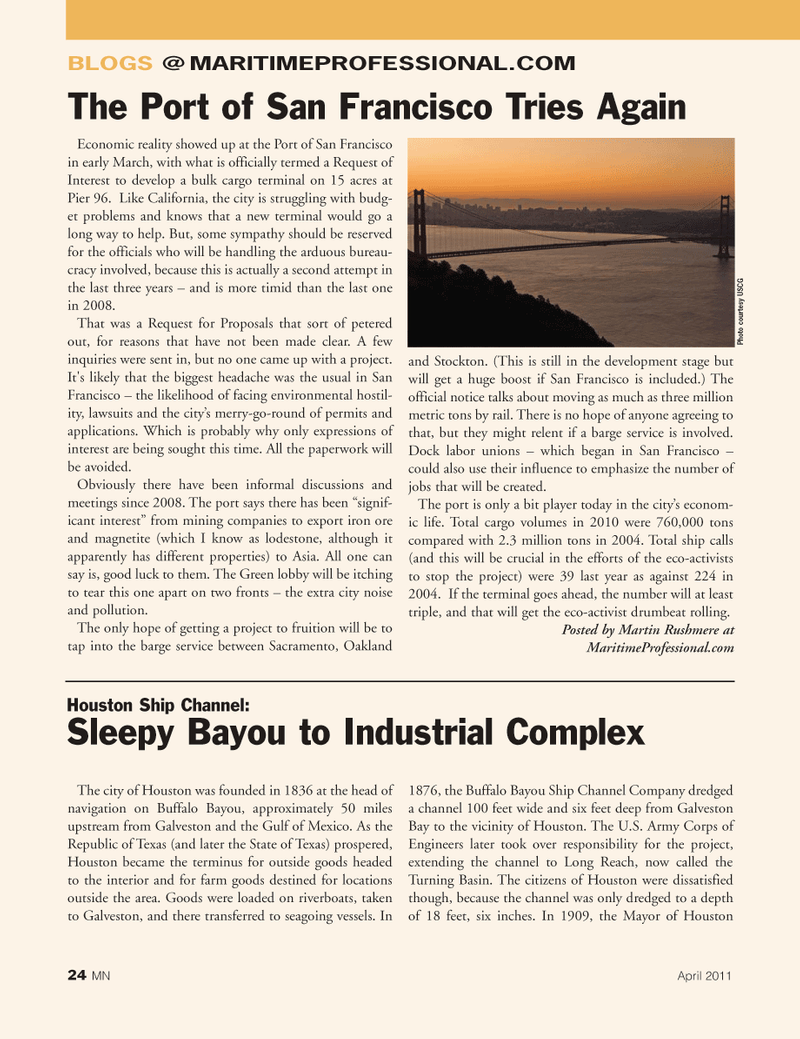
Page 24: of Marine News Magazine (April 2011)
Offshore Energy Edition
Read this page in Pdf, Flash or Html5 edition of April 2011 Marine News Magazine
24 MN April 2011
Economic reality showed up at the Port of San Francisco in early March, with what is officially termed a Request of
Interest to develop a bulk cargo terminal on 15 acres at
Pier 96. Like California, the city is struggling with budg- et problems and knows that a new terminal would go a long way to help. But, some sympathy should be reserved for the officials who will be handling the arduous bureau- cracy involved, because this is actually a second attempt in the last three years – and is more timid than the last one in 2008.
That was a Request for Proposals that sort of petered out, for reasons that have not been made clear. A few inquiries were sent in, but no one came up with a project.
It's likely that the biggest headache was the usual in San
Francisco – the likelihood of facing environmental hostil- ity, lawsuits and the city’s merry-go-round of permits and applications. Which is probably why only expressions of interest are being sought this time. All the paperwork will be avoided.
Obviously there have been informal discussions and meetings since 2008. The port says there has been “signif- icant interest” from mining companies to export iron ore and magnetite (which I know as lodestone, although it apparently has different properties) to Asia. All one can say is, good luck to them. The Green lobby will be itching to tear this one apart on two fronts – the extra city noise and pollution.
The only hope of getting a project to fruition will be to tap into the barge service between Sacramento, Oakland and Stockton. (This is still in the development stage but will get a huge boost if San Francisco is included.) The official notice talks about moving as much as three million metric tons by rail. There is no hope of anyone agreeing to that, but they might relent if a barge service is involved.
Dock labor unions – which began in San Francisco – could also use their influence to emphasize the number of jobs that will be created.
The port is only a bit player today in the city’s econom- ic life. Total cargo volumes in 2010 were 760,000 tons compared with 2.3 million tons in 2004. Total ship calls (and this will be crucial in the efforts of the eco-activists to stop the project) were 39 last year as against 224 in 2004. If the terminal goes ahead, the number will at least triple, and that will get the eco-activist drumbeat rolling.
Posted by Martin Rushmere at
MaritimeProfessional.com
The city of Houston was founded in 1836 at the head of navigation on Buffalo Bayou, approximately 50 miles upstream from Galveston and the Gulf of Mexico. As the
Republic of Texas (and later the State of Texas) prospered,
Houston became the terminus for outside goods headed to the interior and for farm goods destined for locations outside the area. Goods were loaded on riverboats, taken to Galveston, and there transferred to seagoing vessels. In 1876, the Buffalo Bayou Ship Channel Company dredged a channel 100 feet wide and six feet deep from Galveston
Bay to the vicinity of Houston. The U.S. Army Corps of
Engineers later took over responsibility for the project, extending the channel to Long Reach, now called the
Turning Basin. The citizens of Houston were dissatisfied though, because the channel was only dredged to a depth of 18 feet, six inches. In 1909, the Mayor of Houston
BLOGS @ MARITIMEPROFESSIONAL.COM
The Port of San Francisco Tries Again
Photo cour tesy USCG
Houston Ship Channel:
Sleepy Bayou to Industrial Complex

 23
23

 25
25
